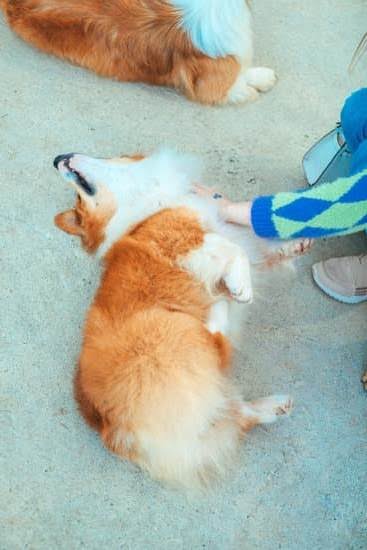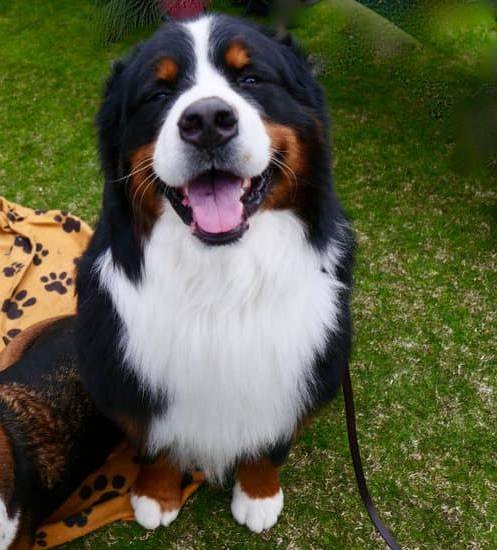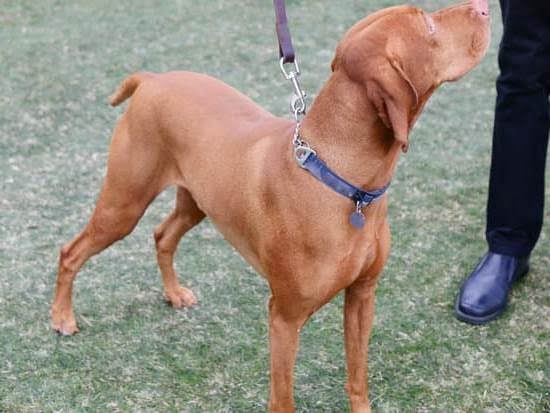Introduction
PTSD or Post-Traumatic Stress Disorder is an anxiety disorder caused by a traumatic event. It can manifest itself in the form of negative behaviors, such as avoiding contact with people and places, trembles, excessive barking, hiding or cowering away from people, and other signs. In addition to these symptoms, PTSD in dogs may include aggression towards people or other animals. For example, if a dog had experienced physical abuse previously or was suddenly released into a new environment after being confined in a small space for an extended period of time.
For dogs suffering from PTSD there are various therapeutic interventions available to help them cope with their anxieties and regain trust in humans and their surroundings. Training methods should be tailored to the specific needs of each dog. A combination of positive reinforcement techniques such as rewards for desired behaviors (giving treats), constructive criticism (corrective body language) and distraction activities (playing fetch) can help make the dog associate positive experiences with certain tasks Soothing environments such as quiet settings (no stimuli) and outdoor walks can also provide calming effects; bringing out happy memories that soothe the animal’s nerves while pushing away any negative associations they might have with certain situations.
In extreme cases where other forms of therapy have failed to yield desired results, drug therapies such as anti-anxiety medications may be prescribed alongside specialized behavior modification plans designed by canine behavioral experts. Lastly, alternative treatments like aromatherapy and massage can be used to relieve tension and stress associated with trauma for both humans and dogs alike; allowing them to develop stronger connections with each other through petting which ultimately leads to improved relationships over time.
Establishing a Positive Relationship with Your Dog Prior to Training
Prior to beginning training for PTSD, it is important to establish a positive relationship with your dog. This can include spending time playing together, going on walks together every day, and providing plenty of love and affection. This helps create a foundation of trust between you and your dog to work from during the training process. Training should involve positive reinforcement, such as treats or verbal praise, to focus on reinforcing good behaviors while correcting those that pose triggers or risks. Additionally, make sure your dog has access to its own space away from any commotion or noise that would be considered triggering activities. Creating clear boundaries of what is acceptable behavior and ensuring healthy distractions will help your dog better manage stress levels during training sessions.
Practicing Reward-Based Training Strategies
Training a dog for PTSD (Post Traumatic Stress Disorder) can be an intimidating task. Fortunately, there are some reward-based training strategies that can make it easier. Positive reinforcement is key to effectively training any animal, and It’s particularly important when training dogs for PTSD, as experiencing a traumatic event can cause fear and anxiety in animals, making them more prone to negative emotions and behavior.
When using reward-based training strategies for a dog with PTSD, start out by teaching the dog the basics like sit, stay and come before expanding on those commands. Rewarding even the smallest accomplishments with treats or praise will help build your dog’s confidence while reinforcing that behaviors desired by you are desirable overall.
To review and refine behaviors already learned, practice doing short “training sessions” 1-2 times per day with your pup in order to prevent boredom and frustration. Practices should be kept short (less than 15 minutes) but be sure to end each session with something fun before wrapping up so that they still get to experience something enjoyable while being trained. Additionally, be patient; progress may come slowly at first but your pup will eventually understand what you’re asking of them if you consistently use positive reinforcement techniques. If your pup should become overwhelmed by their session or stray from commands given remember to remain calm and understanding — this too shall pass!
Avoiding Unnecessary Stressors During Training
When training a dog with PTSD, it is important to avoid any unnecessary stressors. This could include incidents of loud noises, strangers, and other triggers that might cause the dog distress. If any of these triggers become too overwhelming for the dog and they display signs of distress or agitation, remove them from the situation. Instead of trying to force them through it, give them a break and try again later with a more gradual approach. Be sure to reward the dog for making small steps in their progress in order to encourage and motivate them.
In addition to avoiding triggers and distractions during training sessions, it is also important to keep these training sessions short on time but high on reward-driven activities. Dogs with PTSD can draw energy from their fear or anxiety at certain stimuli so keeping things short will help prevent becoming overly overwhelmed. It is also important that each session begin in an area that is safe and free from distractions. Establishing an area as a “safe zone” or “calm down” spot can help reduce stress when introducing new tasks or situations. Finally, incorporating playtime such as tug-of-war or games helps create positive associations with new experiences while allowing dogs to be reinforced for their successes!
Learning About and Analyzing Your Dog’s Reactions and Behaviors
Training a dog for Post-Traumatic Stress Disorder (PTSD) can be challenging. The first step is to understand your dog and the behaviors it exhibits when triggered. It is important to monitor your dog’s activities and reactions in order to find patterns in their behavior and better determine what causes them distress. Once you have an understanding of what triggers your dog, you can begin the process of addressing their responses to those triggers.
The next step in training your dog for PTSD is introducing positive reinforcement—like verbal cues or treats—to encourage desirable behaviors while rewarding or ignoring undesired behavior. Redirecting their attention away from triggers is critical to successfully managing their PTSD symptoms. Additionally, you should create a consistent routine that allows your pup to feel safe and secure in their environment. Familiarization with commands such as sit, stay and come can also help train your dog to remain composed in potentially stressful scenarios that may trigger an adverse response.
If the situation persists, enrolling your pet into therapy specifically designed for dogs with anxiety, fear or phobias can greatly assist in helping them cope with difficult feelings associated with PTSD. Sessions practiced over a period of time may result in long-term behavioral modification so that your pup may lead a more enriched life without feeling hindered by trauma from the past.
Setting Clear and Attainable Goals
When training a dog for PTSD, it is important to set clear and attainable goals. This will help the dog understand what you expect of them and will empower them to succeed. It is also important to make sure that the goals are attainable, as setting unrealistic expectations can often lead to frustration or disappointment. Consider starting with general obedience commands such as sit, stay and come when called. These commands will serve as the foundation for more advanced training as your dog gets used to working with you. Additionally, it is also beneficial to make note of triggers that may cause your dog distress or discomfort and plan accordingly when training. Ensure that your sessions are positive and reward-based rather than focused on punishment; this will foster an atmosphere conducive for success. Celebrate each milestone achieved by both you and the pup during their PTSD training!
Strengthening Your Dog’s Trust in You
One of the most important steps in training a PTSD service dog is establishing an unbreakable bond of trust between you and your dog. This requires that you, as the handler, be calm and consistent when interacting with your pup. The first step is to ensure that they know they can rely on you by providing regular meals, clean living areas, and plenty of one-on-one quality time. Whenever possible, let the dog make decisions for themselves, such as which exit to take from the room or where to go for walks. Always praise them for displaying good behavior or making a “right decision” – this will enhance their self-confidence and allow them to trust you more. Additionally, if you ever need to reprimand them or issue a verbal correction, make sure it’s done in such a way that still emphasizes your loyalty so that doesn’t cause mistrust.
Finally, give them quick access to comforting tools such as toy chewies or blankets that tip off your dog’s calming response system during especially tough moments. This rewards good behavior while helping manage anxiety and can ultimately increase their comfort in times of increased stress or panic attacks. With these things in mind and lots of patience, it won’t be long before you have an incredibly loyal companion who can help you through the toughest times.
Maximizing Positive Reinforcement to Motivate Your Dog
It can be difficult to train dogs for Post-Traumatic Stress Disorder (PTSD). Positive reinforcement is one of the most successful methods for training any animal, including dogs. Be sure to reward your dog with verbal praise, treats, and/or cuddles when they do a task correctly. This motivates them to repeat that behavior in the future. Timing is also critical – make sure you reward your dog immediately after they have finished the task so they learn which behaviors will earn rewards.
In addition to positive reinforcement, it’s important to develop consistency with your commands and criteria so that your dog learns what behaviors are expected of them. You should aim to stick to the same “cue words” when asking your dog something; this way they can learn associative cues faster and remember them better. If there are expectations such as waiting until you give permission or following steps before proceeding with a new task, maintain this structure prior to introducing something different. For instance, if it requires “sit > stay > lay down” consistently each time so that your dog knows what is expected of them regardless of the environment or commands given. Finally, it’s helpful to add simple tasks in between commands so the sequence isn’t overwhelming for your pup; taking a few steps backwards and then continuing forward is one example. If you follow these tips you should be able to effectively train your dog for PTSD!
Understanding the Benefits of Socialization and Interaction
The benefits of socializing and interacting with your dog can be especially beneficial for individuals living with Post-Traumatic Stress Disorder (PTSD). For example, exposure to another living creature can provide emotional support and assist in managing symptoms such as anxiety. Additionally, establishing a routine for your pup—which can include going for walks, playing fetch, or working on commands like ‘sit’ or ‘stay’—can help those living with PTSD become more grounded in the present moment. Studies have consistently shown that the presence of a pet can lead to greater overall well-being.
For those just starting their pet training journey, understanding how best to train a dog is key for successful outcomes. One important factor is to develop a positive training environment through safe handling techniques and rewards rather than punishment when teaching commands. Equally important is having patience and consistency; repetition helps build habits over time while being sensitive to both the dog’s capabilities and adapting training sessions correspondingly helps each unique animal reach its full potential. For those who may need additional help while training their pet, speaking with an experienced canine professional serves as an invaluable resource; they will be able to offer personalized advice based on individual needs.
Having companionship not only aids in developing healthy outlets towards stress management but also provides much needed emotional connection; it is believed that dogs are intuitively attune to their owners’ social cues and are capable of providing comfort of comfort during times of distress or even danger. Fostering accountability as an owner by consistently monitoring behaviors utilizes basic obedience strategies which encourages skills such as focus and reliability. As a result from forming these familiar routines with your pup, behavior patterns influenced by PTSD can begin evolve towards more positive reactions not just towards the canine companion but also other people. With diligent effort and patience over time, pet training can genuinely foster meaningful relationships steeped in empathy between humans and their furry friends – so always give yourself grace during the process!
Coping With Stressful Situations
Training a dog for living with someone who has Post Traumatic Stress Disorder (PTSD) can be a complex process. It is important to introduce strategies that will help the dog cope in very specific and unique situations when the person with PTSD is having a painful experience or memory. Depending on the severity of the individual’s disorder, teaching them how to handle stressful situations may require patience and diligence.
Firstly, it is important to be consistent every time you are training your pet. This could include setting up regular times for activities such as walks, playing fetch, and cuddling. Ensure that these activities are always structured in an orderly fashion so that it becomes a part of your pet’s life routine. Consistency will also allow your pet to recognize certain triggers or cues associated with stressful events, enabling him/her to manifest more appropriate behavior during periods of heightened anxiety.
When it comes to handling emotional stress, comforting measures designed for humans are also effective for animals. Talk soothingly and calmly, offer gentle strokes and massages and provide treats as rewards for positive behaviors that show signs of stress relief. Depending on the comfortability between you two, hug your pet or allow close contact if this helps reduce stress levels in both parties involved.
Additionally, find ways to channel your pup’s energy during peak times of fearfulness by coming up with activities like nose-work exercises and retrieving games like hide-and-seek where dogs search for treats provided by their owners in exchange for rewards like special pats and praises when found. These bonding experiences not only create an environment of trust between you but also help redirect negative energies into something constructive and calming that can ease pronounced forms of anxiety in serious cases as well as minor signs of tense behaviors in milder ones directly connected with PTSD-induced moments.
Working with a Professional Trainer or Veterinarian
If you have a dog with PTSD, talking to a professional or veterinarian about your options is the key first step. Your veterinarian or a professional trainer can help you craft a training plan for your dog that will help them cope with their symptoms.
First, work out what triggers cause the most distress for your dog and label them accordingly. This will help aid in crafting a plan tailored to the needs of your pet based on the triggers they react to most strongly. Work together with either the professional or vet to explore activities that can keep these reactions manageable and exposure techniques such as classical conditioning; this could include teaching your pet specific commands that give them something else to focus on when panicked.
Every dog is different, so be sure to adjust each element of the plan accordingly. If one approach doesn’t work for your pet, explore other options suitable for their needs. Together with your trainer or vet, create new coping strategies throughout individualized sessions and make sure there is structure and consistency in reward systems used throughout training sessions. Lastly, take regular breaks from training sessions to avoid any potential stress spikes – allowing time for play between lessons can be an effective way of helping both you and your dog enjoy each session while gently reinforcing positive behaviors at the same time.
Adjusting to New Environments and Sense of Security
When training a dog for PTSD, it is important to make sure they feel comfortable in different environments and settings. This means helping them to learn basic commands and providing positive reinforcement when they obey calmly. Take your canine companion to new places such as parks, beaches, and pet stores so they can become accustomed to different settings. It’s also important to let them explore their environment with caution rather than trying to make them jump into a situation quickly; this will help them develop a sense of security. Engage in activities that they are comfortable with while out such as fetching or walking on the beach; this will create an enjoyable experience for both the handler and their pup. If the dog shows signs of stress or anxiety, take a few moments for some calming exercises like deep breathing and slow walks which encourage relaxation. Lastly, always have multiple treats on hand so you can reward desired behavior with something tasty!
Preventing Plateaus and Overcoming Setbacks
Training a dog for PTSD can be a challenge, especially when the dog hits plateaus or experiences setbacks. Plateaus occur when the dog does not seem to make any progress despite trying different commands and training methods. Setbacks may happen when the dog learns something new but regresses to old behaviors due to mental fatigue or being overwhelmed by different environments.
To help your dog get past these issues, it is important to keep their training sessions fun and interesting. You can do this by varying the command routines and using reward-based systems such as clicker training or treats. It is also helpful to reinforce commands periodically with treats or vocal praise even if they were learned some time ago to remind them that they are doing well. Additionally, you should attempt to gradually introduce your pet to new stimuli such as unfamiliar terrain, noises, people, etc in order to build up their confidence and positive responses in stressful situations.
Most importantly, remain consistent and patient with your four-legged friend since they can sense your feelings! Taking breaks during training sessions will help alleviate stress in both of you so don’t be afraid to give an occasional breather. Remember that it takes time and dedication especially if dealing with a fear-motivated behavior like PTSD so stick with the program for long-term success!
Incorporating Mental Activities and Games
Training a dog for PTSD is a unique process that involves more than just basic obedience. A major component of successfully training a dog for this condition is to incorporate mental activities and games into the dog’s daily routine. This helps keep the dog mentally active, engaged, and comfortable in social situations which will be beneficial for when they accompany their owner with PTSD. Some popular mental activities or games you can easily implement in your dog’s training include:
• Playing hide-and-seek – rewarding your dog with treats when they find you hidden around the house or in various places
• Puzzle toys – filling up interactive puzzle toys with treats to stimulate problem solving and critical thinking skills
• Memory games – testing your dog’s short-term memory by teaching them simple commands and providing treats as rewards after they attentively recall what was asked of them
• Nosework – using treats or toys, teach your pup to identify objects by their smell through searching and seeking activities, making sure to reward them for their successes
You can also work on developing positive behaviors such as “down” or “stop” cues when anxious triggers occur (like hearing loud noises). Furthermore, practice preventative measures like appearing calm in loud environments as well as desensitization exercises. Training sessions should also be kept short; fifteen minutes at most is usually effective while longer periods may cause undue stress. Plus, always remember to reward obedient behavior with positive reinforcement like gentle petting or praise. Finally, establish routines so that your pup knows what is expected of them in different scenarios. Routines will not only help ease anxiety but also make trips out in public easier overall.
Finishing Up
When your dog is starting to show signs of being prepared to re-integrate into society, it is important to make sure that the environment and interactions are positive. This can be done by slowly introducing your dog in controlled environments, as one-on-one situations or in small groups. The more successful interactions and positive reinforcement provided, the greater chance for success. If your dog remains anxious after being around certain people for short periods of time, it is best to allow more time for acclimation before trying again. Additionally, providing treats or other reward-based activities for exemplary behavior will help build trust and confidence in their training and socialization process.
Above all else, it is important that you keep monitoring your pet’s reactions and behaviors during this process. Regularly discussing any underlying issues or obstacles with a qualified professional can help ensure that both you and your beloved companion feel comfortable in any and all settings they encounter. Equally important, progress should never be pushed beyond what your pet can handle and if at anytime they become overwhelmed or aggressive due to fear or anxiety, immediately remove them from the situation until they can relax once again. With patience given plenty of positive reinforcement, you should soon see clear strides towards re-assimilation back into society with both yourself and your four legged friend on the road to recovery!

Welcome to the blog! I am a professional dog trainer and have been working with dogs for many years. In this blog, I will be discussing various topics related to dog training, including tips, tricks, and advice. I hope you find this information helpful and informative. Thanks for reading!





